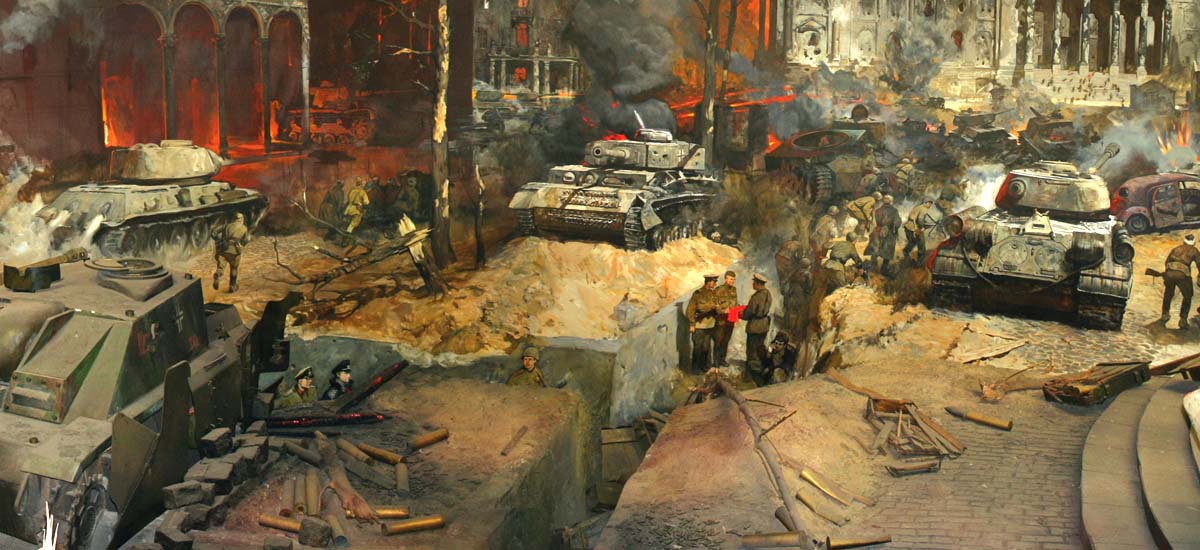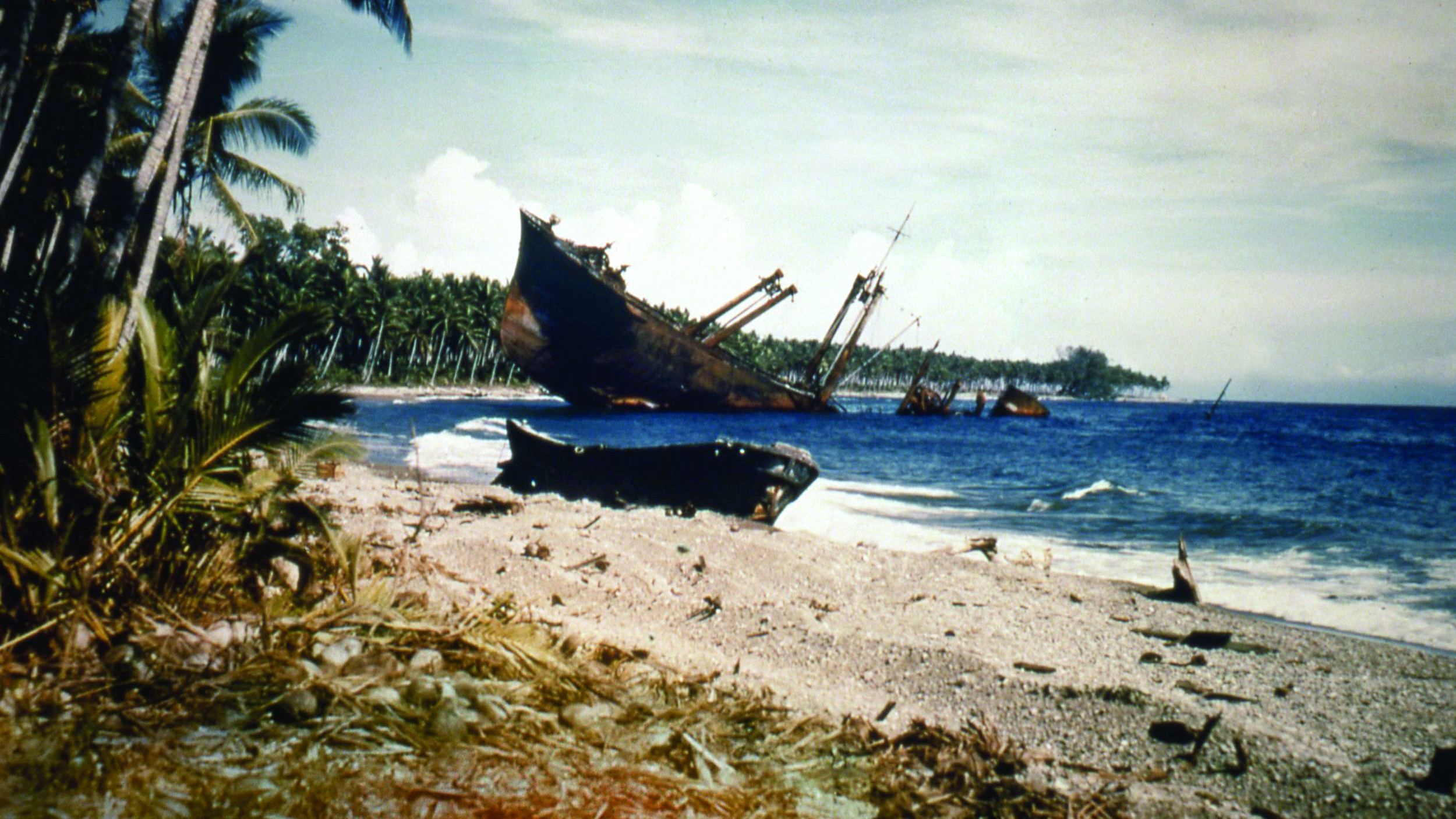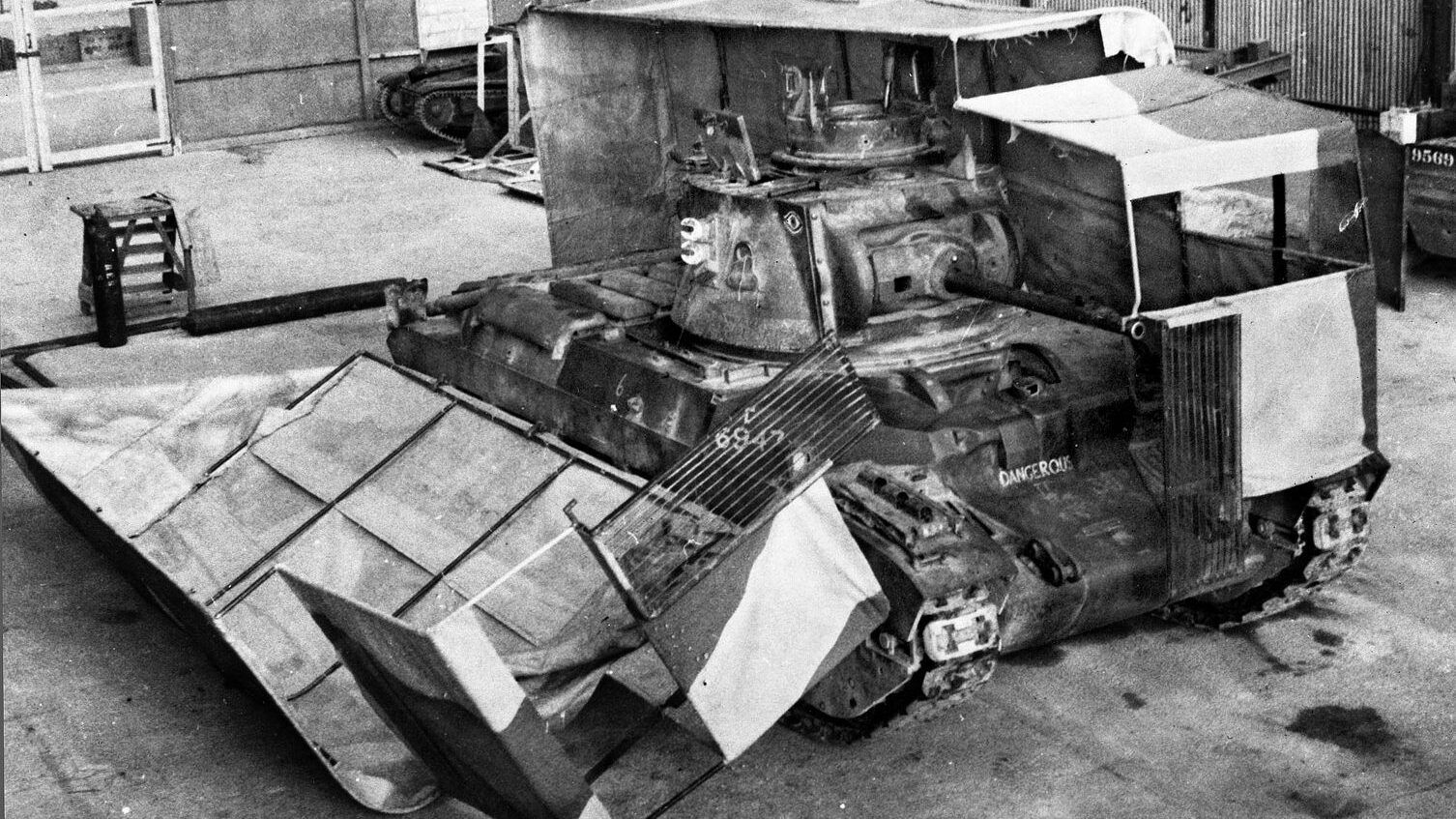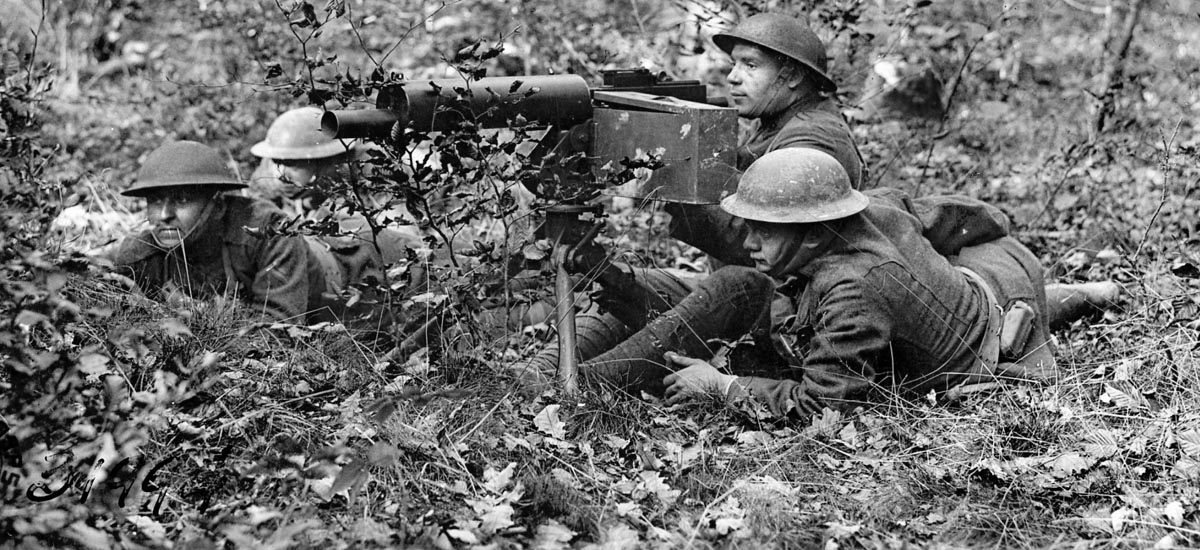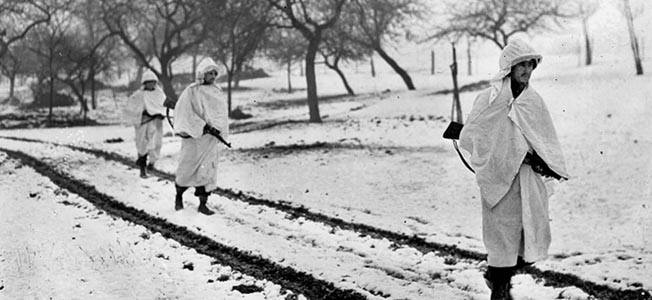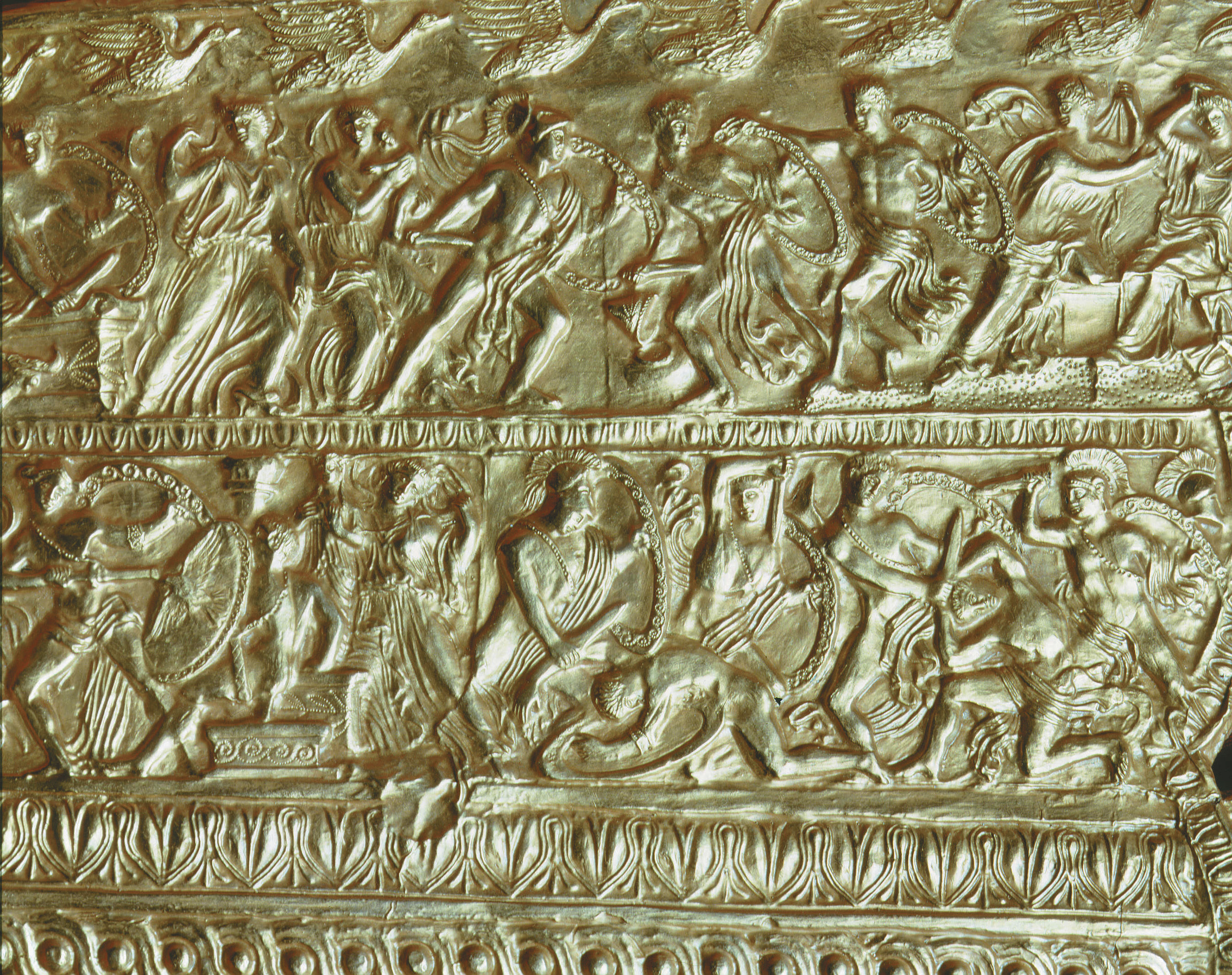By Phil Zimmer
December 1941 was a dark month and the end of a dark year for the Soviets as the Germans pressed ever onward toward Moscow, the lair where Joseph Stalin and his minions plotted what to do next against the Nazi juggernaut that had, in a few short months, rolled over everything before them. Poland had been taken, and then Denmark and Norway, and then Belgium and France had fallen to the Germans, who now had advance units reportedly within eyeshot of the Kremlin. The German commanders were confident. They had never tasted defeat at that point, and a December 4 intelligence report stated flatly that the Soviets were simply not capable of “conducting a counter-offensive without significant reserves.” Unfortunately for the Germans, they had the Soviet T-34 tank to contend with, and they underestimated their opponent. (Read more about the armored vehicles and engineering marvels that turned the tide of the Second World War inside WWII History magazine.)
The ax fell the very next day as the Soviets launched a massive surprise assault that “caught the Germans almost literally frozen in their positions,” as historian Max Hastings aptly describes it. Winter played a hand, with the —30 degrees C temperature freezing the German lubricants while the Russian equipment performed fine, especially the T-34 tanks with their specially designed compressed air starters.
Initially, infantryman Albrecht Linsen could not believe his eyes with the rapid onrush of Soviet tanks and men. “Out of the snowstorm [German] soldiers were running back, scattering in all directions like a panic-stricken herd of animals. A lone officer stood against this desperate mass; he gesticulated, tried to pull out his pistol and then simply let it pass.”
Landser Linsen was momentarily befuddled as well. There was an explosion near him and he “felt a searing pain in my right thigh. I thought: ‘I am going to die here, 21 years old, in the snow before Moscow.’”
The unrelenting Russians—fortified with additional tanks and equipment and bolstered by freshly arrived Siberian troops—charged into the German salients north and south of Moscow and kept pressing forward.
For days the Germans staggered backward from the determined and unrelenting Soviet attacks. The invaders were pushed back between 60 and 150 miles before General Walther Model managed to rally his forces and stop the back peddling in the face of the T-34s.
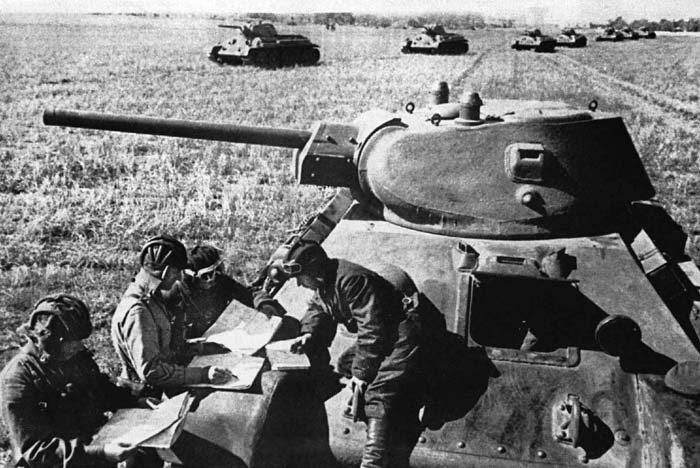
What Made the T-34 Tank So Formidable
The Germans had encountered the sturdy T-34s a few months earlier in their invasion of the Soviet Union. They had learned their Panzer III and IV medium tanks, which had successfully spearheaded the French and Polish campaigns, were simply no match for the powerful and new turret-forward, sloped-armored tanks sent against them.
“Each shot seems to be a direct hit,” one German antitank gunner said early in the June 1941 invasion. But “the shells bounce off. The fire doesn’t seem to bother the tanks in the least,” added the astonished gunner in describing the T-34 and Russia’s heavier, less nimble KV’s ability to ward off German firepower.
The T-34 was equipped with characteristics that the German tankers would come to envy: thicker armor that was sloped to further help deflect enemy fire, a robust V-12 diesel engine, a low profile, and wide tracks that made movement across snow and mud comparatively easy.
The wide tracks proved particularly crucial in traversing the vast stretches of the Motherland with its few, comparatively primitive roads that often became little more than “canals of mud” in the rasputitsa, or the weeks-long wet periods in the fall and spring.
The Germans in 1941 were initially taken aback by the power and effectiveness of the T-34, and they promptly realized the need to gear up and meet the challenges poised by the Soviet tank. In November 1941 a special German armor investigation committee visited Generaloberst Heinz Guderian’s 2nd Panzer Army and examined several captured T-34s.
The outspoken Guderian demanded a complete rethinking of German tanks and called for greatly improved mobility, greater armor protection, and a heavier main gun. This led to two different and competing design approaches by the Nazis. One, led by Daimler-Benz (designer of the Panzer III), envisioned a tank similar in appearance to the T-34 and powered by a 650-horsepower diesel engine and rear-wheel drive.
Would Panthers Be a Match for the T-34?
A second design by the MAN group, designer of the Panzer I and II tanks, called for a vehicle built around the new Maybach HL 210 gasoline engine that had just entered production. It featured a centered-turret design and front-wheel drive, both features not found on the T-34.
The MAN design won out and it became the Panther. That was largely because it could be put into production earlier than the Daimler-Benz model. Subsequent design changes resulted in a 45-ton tank that had grown in weight by a full 50 percent in less than three months of planning. The inherent advantages of a diesel engine and rear-wheel drive were passed over in the push toward prompt production.
Ironically, MAN lacked the ability to construct large numbers of Panthers itself and came to rely on a large number of sub-par subcontractors, including several French firms. As it turned out, the increased weight put too much strain on the untested engine as well as on its transmission and drive train.
Unlike the T-34, the Panther never underwent serious mobility or field trials but was rushed into service against the advice of Guderian and others. While the vehicle sported a superb L/70 70mm main gun and thick, sloped armor, it fell short in other important categories. Reliability and a fuel-efficient diesel engine had been given short-shift in favor of expediency.
Ironically, battlefield realities in 1941 had forced a rethinking and reworking of German tanks, “but German developers erred grievously by building a tank that essentially ignored” those very realities.
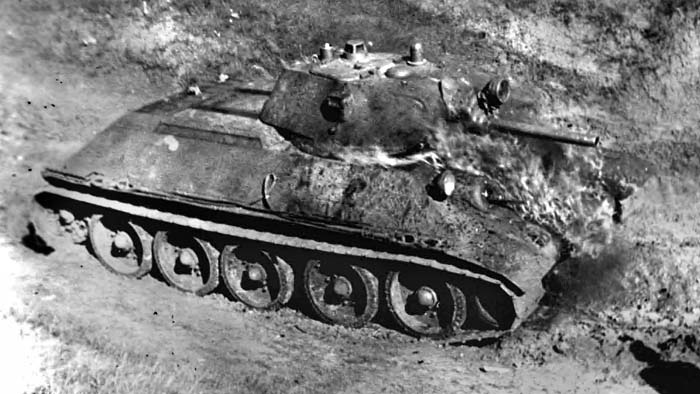
Soviet Innovations Thanks to American Engineer J. Walter Christie
The Tridtsatchetverka, or T-34, came equipped in the early stage of the war with a 76.2mm high-velocity gun that could take out opposing German medium Panzer tanks with their lighter armor and shorter 75mm main guns.
The Soviet tank was based in good portion on a design from innovative American engineer J. Walter Christie who used a then-novel suspension system that enabled the tank to move quickly over uneven ground. The ability and ease of movement across the Russian steppes was critical throughout much of the war. That was very much the case, especially when skilled Soviet gunners learned to fire on the move.
The initial design of the T-34 certainly proved effective when deployed and used properly. It was based on lessons learned by the Soviets in the 1939 Mongolian-Manchurian border clashes with the Japanese and earlier in the Spanish Civil War. The thin-armored, gas-fueled light tanks were not up to the task, and Soviet officials quietly called for the development of a completely new tank.
A number of prototypes were secretly produced by the Soviets, some using the standard 45mm main gun and others equipped with a larger 76.2mm gun. Initial Soviet ventures into Finland in late 1939 proved disastrous, with the loss of 80 tanks in the first week alone to Finnish antitank guns.
This prodded Stalin’s bureaucracy to select a prototype built at a locomotive factory in Kharkov that became the T-34. That initial go-ahead came after a grueling road test and demonstrations that the tank’s maximum of 44mm of sloped armor could withstand fire from 45mm AT guns.
Secret mobility tests had been run at the Kubinka test area against a Panzer III purchased from then-ally Germany. The prototypes were then driven back to the factory in a 1,802-mile round trip and later successfully used in a demonstration blowing up captured Finnish bunkers.
The tests proved the ruggedness of the vehicle’s diesel engine and the strength of its main 76mm gun. The powerful diesel engine and the suspension system enabled the designers to emphasize mobility. It offered better range and a full 30 percent more power than any other contemporary tank engine. But the transmission, similar to that of the Soviets’ earlier light tanks, needed further improvement and refinement as did its steering system.
The Full-Scale Rollout of T-34s
By March 1940 the Defense Ministry approved the full-scale production of the new tank at the Kharkov plant with the use of the main gun from the Kirovski Works facility and the diesel engines from Factory #75 in Kharkov. The initial T-34/76 1940 model weighed in at slightly more than 26 tons and featured the L-11 76.2mm gun. An improved 76.2 gun was planned for the following year along with a cast iron turret with thicker armor
By the time of the 1941 invasion of the Soviet Union, the Kharkov factory and the Stalingrad Tank Factory combined had produced some 1,226 T-34s, in a fairly even mix of the Models 1940 and 1941. Older, outdated light tanks comprised the vast majority of the tanks the Soviets had at the outbreak of war, with only five percent being T-34s.
Some 985 T-34s were stationed in western Russian when the fight began, according to U.S. military strategist Robert Forczyk. Those technically advanced machines were at the ready, but inadequate Soviet training and poor logistics led to debacles, despite their ability to ward off the German 37mm AT fire. The ill-prepared Soviets fought bravely but often had no armor-piercing rounds and only one topping of fuel per tank.
“The best-designed tank in the world is merely scrap iron if it doesn’t have ammunition, fuel, or a trained crew,” observed Forczyk, and that was the condition of the T-34s all that summer as the Germans pushed ever eastward into the interior of the nation that Hitler had predicted would fall like a house of cards.
The onslaught was unrelenting, and by early July fully half of the available T-34s had been lost as the poorly prepared and poorly led Soviet border armies were ground under. Many of the remaining T-34s were lost shortly thereafter when the Kiev pocket collapsed.
The Soviet pushback at Moscow gave the Russians breathing room and, in a Herculean effort, they managed to relocate the crucial Kharkov tank factory and other crucial production facilities eastward to the Urals, well away from the fighting. The resulting Model 1942 had an improved frontal armor of 65mm (from 45mm) and a simplified design to speed production.
The Soviets managed to produce 12,553 T-34s in 1942 but fully 51 percent of those were lost in the fierce fighting that followed as the Germans learned to use the 88mm gun to their advantage against the still poorly trained and undersupplied Soviet tankers.
Learning Some Hard-Won Engineering Lessons from German Encounters
By the middle of that year plans were underway for a Model 1943 that would feature an improved hexagonal turret with two hatches for increased crew safety and slightly thicker turret armor of 70mm. Visibility remained a problem for the tank commander and that was not resolved until mid-1943 when a small cupola was designed for the turret top.
More important, the Model 1943 replaced the 76mm gun with what had been the M1939 85mm antiaircraft gun to form the T-34/85. The 85 had a heavier projectile than the 75mm gun on the new German Panther, but the German tank was able to penetrate thicker armor at a longer range, thanks to the use of more propellant and a longer barrel.
By that stage of the war, the Soviets had learned some hard-won lessons from their opponents on how to stage and fight a quick-moving, armor-thrusting war. Both their training and their tanks had improved, and the Soviets did not religiously subscribe to the theory that the best antitank weapon was solely another tank. They used easier to produce—but highly effective—artillery and self-propelled antitank guns to a full measure.
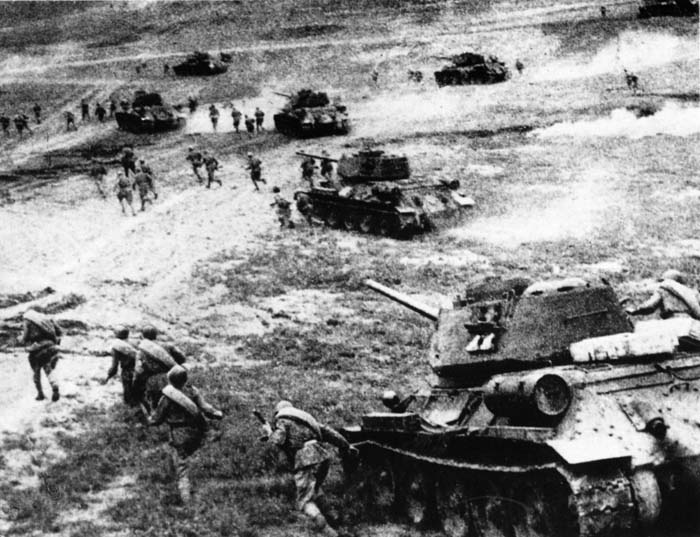
They also came to have faith in the distinctive long-barreled Degtyarev antitank high-velocity rifle that could hurl a deadly 14.5mm projectile at more than 1,000 meters per second to knock out Panzer IIs, or perhaps even disable the tracks of the heavier German tanks.
The Soviets also used their 85mm gun, a close relative of the German 88, in an anti-aircraft role, a move that helped protect its advancing tank and infantry units from what in the past had been truly punishing and deadly air attacks
Soviet depth and sophistication had grown by that point so that tank repair and service battalions traveled right behind the advancing units, ready to retrieve and repair damaged Russian tanks. The Soviets even had one special unit for the evacuation of captured German tanks that were then repaired, reequipped and repainted, and sent into action against their makers.
The T-34/85 became the mainstay going forward, but the Soviets continued to employ their light tanks and Lend-Lease tanks in independent brigades, most often as infantry support. The T-34s also saw some modified use in clearing minefields, a task most often handled by “tramplers”—men in penal battalions who cleared areas on foot.
“To Stop Is to Die”
The struggle on the Eastern Front had taken on gigantic proportions by the time the German 6th Army surrendered on February 2, 1943, at Stalingrad. A brilliant and bold counteract in the Ukraine by General Erich von Manstein shortly thereafter destroyed the overextended Soviet 3rd Tank Army and led to the Nazis retaking Kharkov. The Germans quickly set about planning Operation Citadel, using components of two large army groups, in an effort to encircle and destroy Soviet forces in the Kursk salient.
The Germans felt the newly designed Panthers along with heavier Tigers and the Ferdinand tanks with their larger guns could deal a decisive blow to their foes. Serious technical problems with the MAN-designed Panthers delayed the operation several times, providing additional time for the Soviets to reinforce, dig in their guns, lay additional mines, and construct more tank traps.
The Panthers, dogged by design and production problems, did not arrive by rail until early July, providing little if any time for those tanker crews to be properly briefed. The Soviets had some 3,350 tanks, including about 2,300 T-34s, and thousands of AT guns laying in wait. For one of the few times at that point, they would be able to face their opponent properly prepared and fully armed with the best in Soviet armor and about 50 percent of their available tanks.
The Soviets, in short, still had another half of their T-34 tanks available for use elsewhere on the Eastern Front while the Germans had virtually stripped other sections of the front to mount Citadel.
The Soviet supply system had improved to the point that the T-34 gunners now often consumed their full allotment of ammo in a single outing, while their German counterparts were forced to be more conservative because of an uncertain, intermittent supply system that had been disrupted by Soviet partisan activity and Allied bombing at home.
The Soviet gunners had learned that their tank could not only move faster, but its turret could turn five times faster than the turret on the heavier, underpowered Panther D and some 50 percent faster than the Panther A. This gave the Soviets even more reason to close fast, helping to cancel their opponent’s advantage of a larger, more powerful main gun, while taking advantage of the T-34’s speed and maneuvering abilities.
“To stop is to die,” is a paraphrase of Tanker Georgi Nikolaevich Krivov’s comment. That was especially true later in the war with the arrival of the Panther with its 75mm gun, larger German tank killers armed with the deadly 88, and the improved use of existing field guns. The panzerfaust, the shoulder-fired antitank weapon developed late in the war, was yet another reason not to stop or slow in the advance toward the enemy.
Mobility is a key to tank warfare and, as noted earlier, the more nimble T-34 with its wide treads and exceptionally dependable diesel engine proved its worth in the Eastern Front’s exceptionally poor field conditions. The German engineers had also discounted the T-34’s Christie suspension system and developed a complex running gear that tended to clog up.
More Panthers were often lost due to mechanical breakdowns than enemy fire in 1943. The Germans discovered that some 90 percent of the tanks suffered transmission failures after less than 1,500-kilometers of combat, and the Panther D endured continued fuel pump problems.
Fuel for German vehicles became an issue from that point on, and the Panther’s rapacious thirst for gasoline did not help matters. The Panther, in fact, required almost twice as much fuel to go the same distance as a T-34, yet the Soviet tank consumed easier to produce diesel fuel.
The T-34/76 was further “up-gunned” toward the end of the war with the Soviet’s proven 85mm gun. The T-34/85 began rolling off the assembly lines in January 1944. Those enabled the Soviets to take on the lumbering tank killers that the Germans had fielded. “Prior to that, we had to run like rabbits and look for an opportunity to turn and get at the flanks” of those huge, slow-moving tanks, admitted tanker Nikolai Yakovlevich Zheleznov.
Victory Built on the Back of Improved Weaponry
The Soviets were able to produce nearly 87,500 tanks of all kinds during the war, including some 64,550 T-34s, along with another 22,300 self-propelled guns and countless thousands of artillery pieces.
From 1943 onward the Soviets proved they had truly come into their own, having learned hard-fought lessons from the very best then in the world. By studying the enemy’s tactics they had gauged how to put their growing array of tanks, self-propelled guns, improved artillery, and even antiaircraft weapons to good use.
They had learned how to use their smaller tank to its fullest advantage in tangling with the Panthers and other larger tanks. By that time, they even had the depth in trained and experience manpower to create an additional 27 tank destroyer brigades and 36 antiaircraft divisions to provide further protection for their field armies.
The degree of increased Soviet sophistication can be gauged by its 1944 Field Regulations of the Red Army or Ustav. It stressed a systematic approach, using artillery and air offensives to provide continuous support for attacking Soviet infantry and tank-thrusting units. Ustav emphasized maneuver, surprise, and initiative (MSI) that was a far cry from the largely ham-handed Soviet actions early in the war.
It was the combination of hard-earned experience, knowledge and improved weapons—spearheaded by the T-34—that made the difference as the Soviets pushed ever westward toward Berlin and victory over the invaders of the Motherland.
